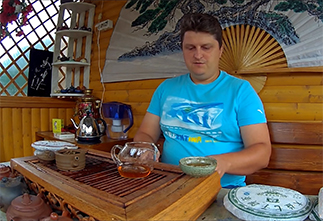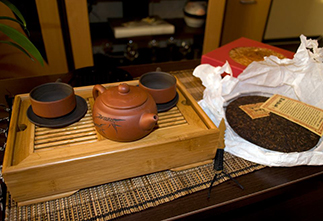Chinese tea Shu Puer 2022 "Pu-erh Brick Tea" of the brand "Sacred Flame" of the plant "Xiaguan"
Shu Pu-erh 2022 "Pu-erh Brick Tea" from the "Sacred Flame" brand of the "Xiaguan" plant (云南下关沱茶集团, Yúnnán Xiàguān tuóchá jítuán) is a high-quality and aromatic tea that combines rich taste, deep aroma and traditional production technology. This tea is made from 2022 raw materials, fermented in heaps, and pressed into a brick shape (Zhuan Cha) weighing 250 grams. The name "Sacred Flame" symbolizes the energy and warmth that this tea gives, and its quality is confirmed by positive reviews from connoisseurs.
Features of the Xiaguan plant
The Xiaguan plant is one of the most famous puer producers in China, famous for its attention to the quality of raw materials and strict adherence to traditional production technologies. Tea from this plant is distinguished by its rich taste, bright aroma and balanced character.
Characteristics of tea
Appearance
The tea brick has a neat shape, typical of traditional Zhuan Cha. The leaves are evenly pressed, which indicates high quality processing. The color of the leaves is dark brown with golden inclusions of tips.
Aroma
Dry tea has a deep, rich aroma with notes of nut, wood, caramel and a slight earthiness. Once brewed, the aroma opens up, adding hints of dried fruit, chocolate and sweet spice.
Taste
The taste of the tea is rich and velvety. The infusion has a rich dark brown color with ruby reflections. The taste is dominated by warm notes of nuts, caramel, dried fruits and light woody bitterness. The aftertaste is long, with pleasant sweetish and spicy shades.
Energy and Impact
Shu Puer 2022 has a warming effect and promotes relaxation. This tea is ideal for the cold season, as well as for those who appreciate a calm and meditative tea party.
Brewing recommendations
For brewing Shu Puerh 2022, it is recommended to use the steeping method in a gaiwan or Yixing clay teapot. The water temperature should be around 95–100°C. The first steeps should be short (5–10 seconds) to reveal the aroma and avoid excessive bitterness. Gradually, the steeping time can be increased. The tea can withstand up to 8–10 steeps, each of which reveals new facets of taste.
Shu Pu-erh 2022 "Pu-erh Brick Tea" is a unique tea that combines rich taste, deep aroma and rich energy. Its origin from Yunnan province and the use of selected raw materials make it a real treasure for pu-erh connoisseurs. This tea will give unforgettable moments of pleasure and allow you to feel a connection with the ancient traditions of Chinese tea art.
If you are looking for a tea that can surprise you with its versatility and give you warmth and comfort, Shu Pu-erh Brick Tea 2022 is a great choice.
|
Country
|
China |
|
Provinces
|
Yunnan (云南) |
|
Manufacturer
|
Сягуань (云南下关沱茶集团) |
|
Raw material production date
|
2022 |
|
Year of pressing
|
2022 |
|
Pressing form
|
Zhuan Cha (Brick Tea) |
|
Fermentation method
|
In heaps |
- Комментарии
- Вконтакте
Pu-erh is one of the most unique types of tea, which only gets better with age. Many people, when they first encounter this tea, wondered: why is pu-erh more often found in pressed form (cakes, bricks, tochas), and not in loose form? The reasons for this are related to both history and the practical aspects of storing and fermenting tea. Despite modern technologies that allow the production of loose pu-erh, the shape of pressed cakes remains unchanged. And pu-erh is more often found on sale in pressed form, for example, in the form of cakes or bricks, and loose pu-erh is less common. We will talk about the reasons for pressing pu-erh into cakes in this article.
Puer is a unique Chinese tea that is distinguished by its depth of taste, complexity of aromas and versatility of aftertaste. Its taste characteristics are formed under the influence of many factors, from growing conditions to the brewing method. Let's look at the main ones.
The question often arises: how to brew puerh correctly? Sometimes the phrase "to get high" is added to it. Moreover, everyone has their own understanding of this phrase. Some mean vigor, and some - intoxication. So how to brew puerh tea correctly? Let's consider several options.
Traveling through the tea mountains, we found ourselves in another land of blue roofs - the village of Zhongcai, which is located in the Menghai district of Yunnan province. According to tradition, we were shown another local tea tree, which, according to the Chinese, is at least a million years old :) The village is very authentic, not designed for tourists, there are many wild pu-erhs there and, of course, we were warmly received. They treated us to local cuisine and tea. We also asked the residents about the prices of tea and how they have changed in recent years.
The tea ceremony occupies a special place in the centuries-old Eastern tradition. And although the essence of this phenomenon remains constant, the nature and external manifestations of the tea ceremony in different nations have their own national characteristics. In each Chinese province, the tea ceremony and the tea used in it are varied: for example, residents of the southern provinces prefer green tea, and residents of the northern provinces - red tea, in Fujian province they more often use Oolong tea, and in Yunnan province Puer tea is widely known.

























































































